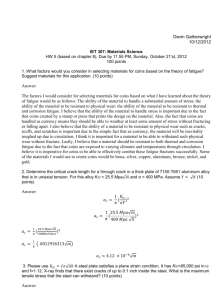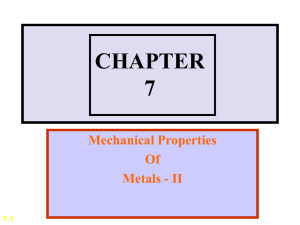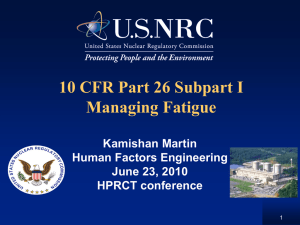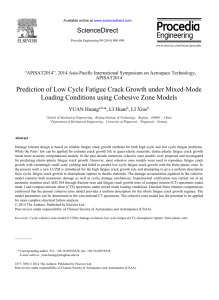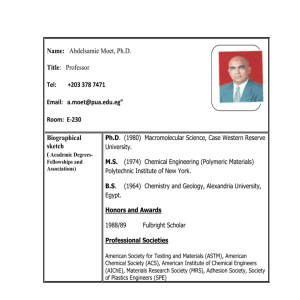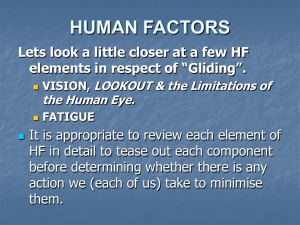fatigue failures
advertisement
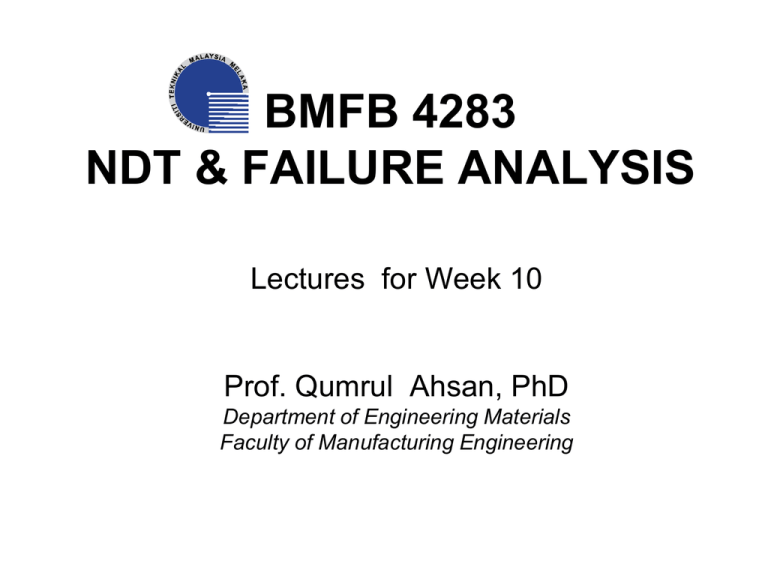
BMFB 4283 NDT & FAILURE ANALYSIS Lectures for Week 10 Prof. Qumrul Ahsan, PhD Department of Engineering Materials Faculty of Manufacturing Engineering Issues to address 10.0 Fatigue Failure 10.1 Introduction 10.2 Factors Causing Fatigue Failure 10.3 S-N Curve 10.4 Fatigue Crack Growth 10.5 Factors Influence Fatigue Properties Fatigue Failure Failures occurring under conditions of dynamic loading are called fatigue failures. metal subjected to a repetitive or fluctuating stress will fail at a stress much lower than that required to cause failure on a single application of load. Fatigue failure is characterized by three stages Crack Initiation Crack Propagation Final Fracture Hawaii, Aloha Flight 243, a Boeing 737, an upper part of the plane's cabin area rips off in mid-flight. Metal fatigue was the cause of the failure. Ken Youssefi MAE dept., SJSU 4 Appearance of Fatigue Fracture Surface Fracture surface of a failed bolt. The fracture surface exhibited beach marks, which is characteristic of a fatigue failure. 1.0-in. diameter steel pins from agricultural equipment. Material; AISI/SAE 4140 low allow carbon steel The final fracture area is clearly identified by its colour - the surface of the crack will be dull due to the effects of air and moisture being in contact and setting up mild corrosion, while the newly failed surface will show signs of new, clean brittle failure Fatigue Crack Nucleation • Flaws, cracks, voids can all act as crack nucleation sites, especially at the surface. • Therefore, smooth surfaces increase the time to nucleation; notches, stress risers decrease fatigue life. • Dislocation activity (slip) can also nucleate fatigue cracks. Fatigue: Crack initiation and propagation • Three stages of fatigue failure: – crack initiation in the areas of stress concentration (microcracks, scratches, indents, interior corners, dislocation slip steps, etc.). Quality of surface is important. – incremental crack propagation – final rapid crack propagation after crack reaches critical size • The total number of cycles to failure is the sum of cycles at the first and the second stages: – Nf = Ni + Np – Nf : Number of cycles to failure – Ni : Number of cycles for crack initiation – Np : Number of cycles for crack propagation High cycle fatigue (low loads): Ni is relatively high. With increasing stress level, Ni decreases and Np dominates Crack propagation • Stage II a: initial slow propagation along crystal planes with high resolved shear stress. Involves just a few grains, and has flat fracture surface • Stage II b: faster propagation perpendicular to the applied stress. Crack grows by repetitive blunting and sharpening process at crack tip. Rough fracture surface. • Crack eventually reaches critical dimension and propagates very rapidly and causes fatigue failure. • Visually a fatigue fracture region is smoother than the overload fracture region Indication of Fatigue Failure Surface Crack initiation site Both marks indicate the position of the crack tip. It appears as concentric ridges (circular or semicircular Beach Mark Fracture zone Beach Mark •Also called calmshell marks •Can be observed using unaided eye •Components experienced interruption during the crack propagation •Each beachmark band represents a time over which crack growth occured Striations • Microscopic in size •Each striation represents crack growth rate • stress range striations width • Multiple strations within a beach mark Fatigue at Stress Raiser • Notches decrease fatigue life through stress concentration • Remove stress concentrators. bad better bad better 928 Porsche timing pulley Crack started at the fillet 25 Thermal cycling causes expansion and contraction, hence thermal stress, if component is restrained. •eliminate restraint by design •use materials with low thermal expansion coefficients Jack hammer component, shows no yielding before fracture. Crack initiation site Fracture zone Propagation zone, striation MAE dept., SJSU VW crank shaft – fatigue failure due to cyclic bending and torsional stresses Propagation zone, Crack initiation site Fracture area bicycle crank spider arm This long term fatigue crack in a high quality component took a considerable time to nucleate from a machining mark between the spider arms on this highly stressed surface. However once initiated propagation was rapid and accelerating as shown in the increased spacing of the 'beach marks' on the surface caused by the advancing fatigue crack. Crank shaft Gear tooth failure MAE dept., SJSU 42 Fatigue: summary • Initiated at surface • Fatigue failure controlled either by initiation or by propagation • Fatigue Fracture Features: Beachmark and Striation • Intrinsic and Extrinsic features control fatigue failure and fatigue life. 43

